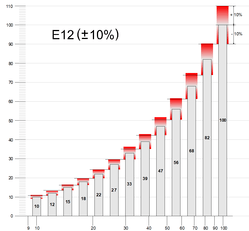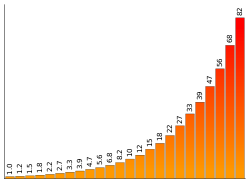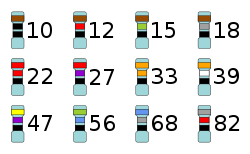E series of preferred numbers


The E series is a system of preferred numbers (also called preferred values) derived for use in electronic components. It consists of the E3, E6, E12, E24, E48, E96 and E192 series, where the number after the 'E' designates the quantity of value "steps" in each series. Although it is theoretically possible to produce components of any value, in practice the need for inventory simplification has led the industry to settle on the E series for resistors, capacitors, inductors, and zener diodes. Other types of electrical components are either specified by the Renard series (for example fuses) or are defined in relevant product standards (for example IEC 60228 for wires).
History
World War II military production was a major influence for establishing common standards across many industries. Later, Post–World War II baby boom and invention of the transistor kicked off demand for consumer electronics goods during the 1950s. As transistor radio production migrated towards Japan during the 1950s, it was critical for the electronic industry to have international standards.
In the early 20th century,[1][2][3][4] resistor and capacitor value increments were much different than today.[5] Over time, products evolved towards common values. Based on some of these existing conventions, the International Electrotechnical Commission (IEC) began work on an international standard in 1948.[6] The first version of this IEC Publication 63 (IEC 63) was released in 1952.[7] Later, IEC 63 was revised, amended, and renamed into the current version known as IEC 60063:2015.[8]
IEC 60063 release history:
- IEC 63:1952 (aka IEC 60063:1952), first edition, published 1952-01-01[7]
- IEC 63:1963 (aka IEC 60063:1963), second edition, published 1963-01-01[6]
- IEC 63:1967/AMD1:1967 (aka IEC 60063:1967/AMD1:1967), first amendment of second edition, published 1967[6]
- IEC 63:1977/AMD2:1977 (aka IEC 60063:1977/AMD2:1977), second amendment of second edition, published 1977[6]
- IEC 60063:2015, third edition, published 2015-03-27[8]
Overview
E series preferred numbers were chosen such that when a component is manufactured that it will end up in a range of roughly equally spaced values on a logarithmic scale. Each E series subdivides the interval from 1 to 10 (decade) into steps of 1, 3, 6, 12, 24, 48, 96, 192. Subdivisions of E3 to E192 ensure the maximum error will be divided in the order of 40%, 20%, 10%, 5%, 2%, 1%, 0.5%. Also, the E192 series is used for 0.25% and 0.1% tolerance resistors.
Currently, the E series is split into two major groupings: up to E24 is one group, and E48 and higher is the other group. The two main differences between each major group is the number of significant digits (2 digits for E3 to E24, 3 digits for E48 to E192) and different rounding rules. Since lower E series up to E24 were defined and established long before the IEC standards were written, older series were not redefined when E48 to E192 series were created, otherwise it would have created problems in production and servicing of established products. It should be noted that some values in the E24 series don't exist in E48 to E192 series.
Example
The E3 series is defined as a series of the numbers 1.0, 2.2 and 4.7. If a manufacturer sold resistors with E3 series values in a range of 1 ohm to 10 megohms, then the available resistance values would be: 1 Ω, 2.2 Ω, 4.7 Ω, 10 Ω, 22 Ω, 47 Ω, 100 Ω, 220 Ω, 470 Ω, 1 kΩ, 2.2 kΩ, 4.7 kΩ, 10 kΩ, 22 kΩ, 47 kΩ, 100 kΩ, 220 kΩ, 470 kΩ, 1 MΩ, 2.2 MΩ, 4.7 MΩ, 10 MΩ.
Obsolete
The E3 series is rarely used, except for some components with high variations like electrolytic capacitors, where the given tolerance is often unbalanced between negative and positive such as −30/+50% or −20/+80%, or for components with uncritical values such as pull-up resistors. The calculated tolerance for this series gives (3√10 − 1) ÷ (3√10 + 1) = 36.60%. While the standard only specifies a tolerance greater than 20%, other sources indicate 40% or 50%. Currently, most electrolytic capacitors are manufactured with values in the E6 or E12 series, thus E3 series is likely obsolete.
E24 vs. E48, E96, E192
Since some values in the E24 series do not exist in the E48, E96 and E192 series, resistor manufacturers have added the missing E24 values to some of their 1%, 0.5%, 0.25%, 0.1% tolerance families. This allows easier purchasing migration between different tolerance parts. This type of combination is noted on resistor datasheets and webpages as "E96 + E24" and "E192 + E24".[9][10][11]
Comparison of E24 vs. E48 values:
- matching – 1.00, 1.10, 7.50
- missing – 1.20, 1.30, 1.50, 1.60, 1.80, 2.00, 2.20, 2.40, 2.70, 3.00, 3.30, 3.60, 3.90, 4.30, 4.70, 5.10, 5.60, 6.20, 6.80, 8.20, 9.10
Comparison of E24 vs. E96 values:
- matching – 1.00, 1.10, 1.30, 1.50, 2.00, 7.50
- missing – 1.20, 1.60, 1.80, 2.20, 2.40, 2.70, 3.00, 3.30, 3.60, 3.90, 4.30, 4.70, 5.10, 5.60, 6.20, 6.80, 8.20, 9.10.
Comparison of E24 vs. E192 values:
- matching – 1.00, 1.10, 1.20, 1.30, 1.50, 1.60, 1.80, 2.00, 2.40, 4.70, 7.50
- missing – 2.20, 2.70, 3.00, 3.30, 3.60, 3.90, 4.30, 5.10, 5.60, 6.20, 6.80, 8.20, 9.10
Lists

List of values for each E series:
- E3 values (>20% tolerance)
- 1.0, 2.2, 4.7
- E6 values (20% tolerance)
- 1.0, 1.5, 2.2, 3.3, 4.7, 6.8
- E12 values (10% tolerance)
- 1.0, 1.2, 1.5, 1.8, 2.2, 2.7, 3.3, 3.9, 4.7, 5.6, 6.8, 8.2
- E24 values (5% tolerance)
- 1.0, 1.1, 1.2, 1.3, 1.5, 1.6, 1.8, 2.0, 2.2, 2.4, 2.7, 3.0, 3.3, 3.6, 3.9, 4.3, 4.7, 5.1, 5.6, 6.2, 6.8, 7.5, 8.2, 9.1
- E48 values (2% tolerance) – (see notes in previous section)
- 1.00, 1.05, 1.10, 1.15, 1.21, 1.27, 1.33, 1.40, 1.47, 1.54, 1.62, 1.69, 1.78, 1.87, 1.96, 2.05, 2.15, 2.26, 2.37, 2.49, 2.61, 2.74, 2.87, 3.01, 3.16, 3.32, 3.48, 3.65, 3.83, 4.02, 4.22, 4.42, 4.64, 4.87, 5.11, 5.36, 5.62, 5.90, 6.19, 6.49, 6.81, 7.15, 7.50, 7.87, 8.25, 8.66, 9.09, 9.53
- E96 values (1% tolerance) – (see notes in previous section)
- 1.00, 1.02, 1.05, 1.07, 1.10, 1.13, 1.15, 1.18, 1.21, 1.24, 1.27, 1.30, 1.33, 1.37, 1.40, 1.43, 1.47, 1.50, 1.54, 1.58, 1.62, 1.65, 1.69, 1.74, 1.78, 1.82, 1.87, 1.91, 1.96, 2.00, 2.05, 2.10, 2.15, 2.21, 2.26, 2.32, 2.37, 2.43, 2.49, 2.55, 2.61, 2.67, 2.74, 2.80, 2.87, 2.94, 3.01, 3.09, 3.16, 3.24, 3.32, 3.40, 3.48, 3.57, 3.65, 3.74, 3.83, 3.92, 4.02, 4.12, 4.22, 4.32, 4.42, 4.53, 4.64, 4.75, 4.87, 4.99, 5.11, 5.23, 5.36, 5.49, 5.62, 5.76, 5.90, 6.04, 6.19, 6.34, 6.49, 6.65, 6.81, 6.98, 7.15, 7.32, 7.50, 7.68, 7.87, 8.06, 8.25, 8.45, 8.66, 8.87, 9.09, 9.31, 9.53, 9.76
- E192 values (0.5% and lower tolerance) – (see notes in previous section)
- 1.00, 1.01, 1.02, 1.04, 1.05, 1.06, 1.07, 1.09, 1.10, 1.11, 1.13, 1.14, 1.15, 1.17, 1.18, 1.20, 1.21, 1.23, 1.24, 1.26, 1.27, 1.29, 1.30, 1.32, 1.33, 1.35, 1.37, 1.38, 1.40, 1.42, 1.43, 1.45, 1.47, 1.49, 1.50, 1.52, 1.54, 1.56, 1.58, 1.60, 1.62, 1.64, 1.65, 1.67, 1.69, 1.72, 1.74, 1.76, 1.78, 1.80, 1.82, 1.84, 1.87, 1.89, 1.91, 1.93, 1.96, 1.98, 2.00, 2.03, 2.05, 2.08, 2.10, 2.13, 2.15, 2.18, 2.21, 2.23, 2.26, 2.29, 2.32, 2.34, 2.37, 2.40, 2.43, 2.46, 2.49, 2.52, 2.55, 2.58, 2.61, 2.64, 2.67, 2.71, 2.74, 2.77, 2.80, 2.84, 2.87, 2.91, 2.94, 2.98, 3.01, 3.05, 3.09, 3.12, 3.16, 3.20, 3.24, 3.28, 3.32, 3.36, 3.40, 3.44, 3.48, 3.52, 3.57, 3.61, 3.65, 3.70, 3.74, 3.79, 3.83, 3.88, 3.92, 3.97, 4.02, 4.07, 4.12, 4.17, 4.22, 4.27, 4.32, 4.37, 4.42, 4.48, 4.53, 4.59, 4.64, 4.70, 4.75, 4.81, 4.87, 4.93, 4.99, 5.05, 5.11, 5.17, 5.23, 5.30, 5.36, 5.42, 5.49, 5.56, 5.62, 5.69, 5.76, 5.83, 5.90, 5.97, 6.04, 6.12, 6.19, 6.26, 6.34, 6.42, 6.49, 6.57, 6.65, 6.73, 6.81, 6.90, 6.98, 7.06, 7.15, 7.23, 7.32, 7.41, 7.50, 7.59, 7.68, 7.77, 7.87, 7.96, 8.06, 8.16, 8.25, 8.35, 8.45, 8.56, 8.66, 8.76, 8.87, 8.98, 9.09, 9.20, 9.31, 9.42, 9.53, 9.65, 9.76, 9.88
Table
|
|
|
See also
- Electronic color code – color-code used to indicate the values of axial electronic components, such as resistors, capacitors, inductors, diodes (also see IEC 60062).
- Preferred numbers
- Renard series
- 1-2-5 series
- Geometric progression
References
- ↑ "1930 Catalog – Page 139 – Capacitors (Condensers)". Allied Radio. 1930. Archived from the original on 2017-07-11. Retrieved 2017-07-11.
- ↑ "1940 Catalog – Page 54 – Capacitors (Condensers)". RadioShack. 1940. Archived from the original on 2017-07-11. Retrieved 2017-07-11.
- ↑ "1930 Catalog – Page 141 – Resistors". Allied Radio. 1930. Archived from the original on 2017-07-11. Retrieved 2017-07-11.
- ↑ "1940 Catalog – Page 60 – Resistors". RadioShack. 1940. Archived from the original on 2017-07-11. Retrieved 2017-07-11.
- ↑ "2017 Catalog – Pages 29 to 41 – Passives" (PDF). Jameco Electronics. 2017. Archived (PDF) from the original on 2017-07-11. Retrieved 2017-07-11.
- 1 2 3 4 IEC 60063:1963 – Preferred number series for resistors and capacitors – Amended in accordance with Amendments 1 (1967) and 2 (1977) (2.0 ed.). International Electrotechnical Commission (IEC). 2007 [1977, 1967, 1963-01-01]. ISBN 2-8318-0027-7. Archived from the original on 2017-11-01. Retrieved 2017-07-11.
[…] During the discussions of IEC Technical Committee 12: Radio-communication, at the meeting in Stockholm in 1948, it was […] agreed that one of the most urgent items for international standardization was the series of preferred values for resistors and for capacitors up to 0,1 μF. It would have been desirable to standardize for these series the -system, but […] in several countries the -system had been adopted […] because of standardization of tolerances at 5, 10 and 20 %. As it was not practicable to change the commercial practice in these countries, the -system was adopted. The Committee expressed regret that […] it was necessary to recommend the -system, although it would have been more consistent with ISO practice to use the -system. The proposal for the series E6, E12 and E24 of preferred values was accepted in Paris in 1950 and subsequently published […] In 1957, the British National Committee came forward with a proposal for E48 and E96 series […] as an extension […] discussed in Zürich in 1957 and Stockholm in 1958 […] at The Hague in September 1959 […] in Ulm at […] October 1959 […] for approval under the Six Months' Rule in March 1960 […] it was decided […] in Nice in 1962 that these series should be published […]
- 1 2 IEC 60063:1952 – Series of preferred values and their associated tolerances for resistors and capacitors (1.0 ed.). International Electrotechnical Commission (IEC). 2007 [1952-01-01]. Archived from the original on 2017-11-01. Retrieved 2017-07-11.
- 1 2 IEC 60063:2015 – Preferred number series for resistors and capacitors (3.0 ed.). International Electrotechnical Commission (IEC). 2015-03-27. ISBN 978-2-8322-2427-4. Archived from the original on 2017-07-11. Retrieved 2017-07-11.
- ↑ "Standard Values Used in Capacitors, Inductors, and Resistors". Bourns. 2017. Archived from the original on 2017-07-11. Retrieved 2017-07-11.
- ↑ "D/CRCW e3 – Standard Thick Film Chip Resistors – Datasheet" (PDF). Vishay Intertechnology. 2017. Archived (PDF) from the original on 2017-07-11. Retrieved 2017-07-11.
- ↑ "TNPW e3 – High Stability Thin Film Flat Chip Resistors – Datasheet" (PDF). Vishay Intertechnology. 2017. Archived (PDF) from the original on 2017-07-11. Retrieved 2017-07-11.
External links
| Wikimedia Commons has media related to E12 values. |
- Calculate standard resistor values in Excel – EDN magazine
- Printable E series tables
- E6 to E96 Table – Servenger
- E3 to E192 Table – Vishay
- E6 to E192 Table – Analog Services